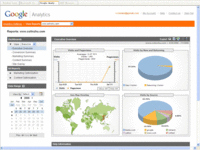 Brands love social media, and as evidenced by the number of high-dollar acquisitions of social media monitoring and analytics firms last year, they love the data that social media generates.
Brands love social media, and as evidenced by the number of high-dollar acquisitions of social media monitoring and analytics firms last year, they love the data that social media generates.
And, on the surface, there's a good reason for that: popular social networks like Facebook and Twitter give brands a front-row seat to the collective conversation consumers are having about their products and services. From that conversation, brands may, in theory, be able to gain valuable insights that help them connect with consumers and serve them better.
Listening and making sense of the conversation, however, isn't easy. The amount of data generated daily on social networks is staggering, creating substantial noise, the most vocal members of the social mediasphere may not be representative of a brand's customers at large, and figuring out what consumers really want and intend to do from their social media postings is not always a straightforward proposition.
Pinterest and Instagram: is a picture worth a thousand words?
Despite these challenges, brands continue to be lured by social media. Many are expanding their social media footprints and investing heavily in tools that are designed to help them manage their presences and sift through social data.
Some of those tool investments are being directed at the latest generation of popular social networks, including image-based services like Pinterest and Instagram. As detailed by AdAge's Kate Kaye, these networks present some interesting challenges. Perhaps the biggest: because they're image-based, measuring and making sense of activity is much more complicated.
Not surprisingly, numerous companies have jumped into the market promising to help. One, Curalate, bills itself as "the leading Pinterest analytics and marketing suite" and claims more than 300 brands as clients, including GAP, Saks Fifth Avenue and Campbell's.
Curalate's CEO, Apu Gupta, detailed how his service can be used:
Photos from Campbell's recipe site Campbell's Kitchen are popular with pinners, said Gupta. The company can use analytics tools to see how it matches up against competitors, he suggested. For example, if the data show that people are keen on posting dessert photos, the classic food brand might want to develop dessert recipes for its recipe site -- or may realize the sweets recipe brand is not a direct competitor after all.
Fool's gold
While it would be unfair to claim that such insights are not insights at all, one should question just how valuable these insights are.
If dessert photos from Campbell's Kitchen site are particularly popular on Pinterest, it would be reasonable to assume that this is a reflection of the popularity of dessert recipes generally, something that would probably be evident in Campbell's analytics for the website. In other words, there's probably no need to measure indirectly what can be measured directly.
Even when it comes to potentially more important metrics, such as referrals from Pinterest that generate sales, there's a question as to the value of data. Curalate, for instance, says it can determine which specific products led to a revenue-producing Pinterest referral. That's intriguing, but the question remains: realistically, what would a retailer actually do with this data?
Questions of data overload and scale
There are two fundamental problems with fixation on social media data:
- Overload. The more data collected from more sources, the more likely it is to cause confusion. To be sure, the data that can be collected from social media, including from image-based networks like Pinterest and Instagram, is interesting, but can and should large brands really make enough sense of all this data to take needle-moving action? In many cases, the answer is "probably not", particularly without normalization and a real methodology for addressing data sources that seem to conflict with each other.
- Scale. For analytics to work, it must be applied in a scalable fashion. Using multiple analytics services, each geared to one or a handful of specific social networks, is an impediment to scale for a variety of reasons. The good news is that low-level analysis of specific social channels often isn't required. Simple cohort analysis can help brands understand the behavior of consumers in different channels so that they can make better informed, high-level decisions about how best to market to them and where to direct them. That can scale; monitoring page or product-level data for ten social networks across hundreds or thousands of SKUs probably won't.
Distilling it down
Obviously, there are few hard and fast rules about how social data should be used. Different brands have different needs and different social media assets. But at the end of the day, all brands should be cautious about falling victim to the notion that data and data analysis are about minutiae.
They aren't, and the truth of the matter is that high-level metrics, like revenue and profit, and the growth rates of both, reveal a lot more than many would like to think, particularly when looked at on a product category or customer segment basis.
Sure, it's fun and interesting to look at data culled from social media, but make no mistake about it: the indirect and often subjective conclusions that are drawn from these sources reveal far less -- and matter far less -- than the top and bottom lines. Put simply, if you can't figure out where your brand stands in a market and what consumers are telling you by looking at these figures, data from Facebook, Twitter or Pinterest isn't going to help.
No hay comentarios:
Publicar un comentario